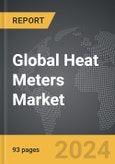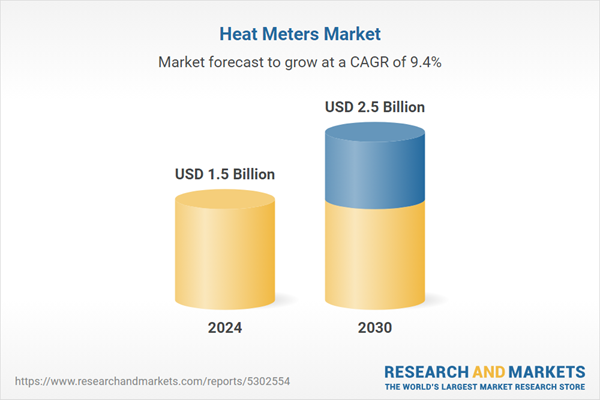Global Heat Meters Market - Key Trends and Drivers Summarized
Why Are Heat Meters Critical for Energy Management and Efficiency?
Heat meters have become essential tools in energy management, particularly in district heating systems and residential energy monitoring. These devices measure the thermal energy delivered to a building or unit, allowing for accurate billing and efficient energy use. The growing focus on reducing energy consumption and improving energy efficiency has made heat meters a crucial component in both residential and commercial applications. Governments across Europe and other regions have introduced regulations mandating the installation of heat meters in multi-occupancy buildings, which has driven the demand for these devices. Moreover, the shift toward sustainable energy practices, such as the integration of renewable energy into heating systems, has further highlighted the importance of precise heat measurement for optimizing energy distribution.How Is Technology Transforming the Heat Meters Market?
Technological advancements in heat meters have led to the development of more accurate, reliable, and user-friendly devices. Modern heat meters are now equipped with digital displays, wireless connectivity, and advanced data logging capabilities, allowing users and energy providers to monitor heat consumption in real time. The integration of Internet of Things (IoT) technology has further enhanced the functionality of heat meters by enabling remote reading, data analytics, and predictive maintenance. Ultrasonic heat meters, which offer higher accuracy and longer lifespan compared to traditional mechanical meters, are gaining popularity in both residential and commercial sectors. The use of smart meters, which can communicate with utility providers and offer insights into energy usage patterns, is also expanding, driven by the growing trend of smart grid infrastructure.How Are Segments Driving Demand in the Heat Meters Market?
Types of heat meters include mechanical meters, ultrasonic meters, and electromagnetic meters, with ultrasonic meters leading the market due to their accuracy and low maintenance requirements. The technology segment includes wired and wireless meters, with wireless meters gaining traction due to their ease of installation and ability to provide real-time data. Applications of heat meters are found in residential, commercial, and industrial settings, with residential usage being the largest segment, particularly in regions with established district heating systems such as Europe. In industrial applications, heat meters are used to monitor energy consumption in manufacturing processes, contributing to greater energy efficiency and cost savings.What Factors Are Driving the Growth in the Heat Meters Market?
The growth in the heat meters market is driven by several factors, including increasing government regulations promoting energy efficiency, the rising adoption of district heating systems, and advancements in metering technology. Regulatory mandates in regions like Europe have been critical in driving the installation of heat meters, particularly in multi-family residential buildings where energy consumption needs to be monitored and billed accurately. The shift toward smart grids and the growing adoption of renewable energy sources are also contributing to the demand for heat meters that can integrate with these systems. Technological advancements, including IoT-enabled meters and real-time data analytics, have enhanced the appeal of modern heat meters, enabling better energy management. Additionally, the global focus on sustainability and reducing carbon emissions is propelling the demand for efficient energy monitoring solutions, further driving the heat meter market.Report Scope
The report analyzes the Heat Meters market, presented in terms of market value (US$ Thousand). The analysis covers the key segments and geographic regions outlined below.- Segments: Type (Static, Mechanical); Connectivity (Wired, Wireless); End-Use (Residential, Commercial & Public, Industrial).
- Geographic Regions/Countries:World; United States; Canada; Japan; China; Europe (France; Germany; Italy; United Kingdom; Spain; Russia; and Rest of Europe); Asia-Pacific (Australia; India; South Korea; and Rest of Asia-Pacific); Latin America (Argentina; Brazil; Mexico; and Rest of Latin America); Middle East (Iran; Israel; Saudi Arabia; United Arab Emirates; and Rest of Middle East); and Africa.
Key Insights:
- Market Growth: Understand the significant growth trajectory of the Static Heat Meters segment, which is expected to reach US$1.6 Billion by 2030 with a CAGR of a 10.7%. The Mechanical Heat Meters segment is also set to grow at 7.2% CAGR over the analysis period.
Why You Should Buy This Report:
- Detailed Market Analysis: Access a thorough analysis of the Global Heat Meters Market, covering all major geographic regions and market segments.
- Competitive Insights: Get an overview of the competitive landscape, including the market presence of major players across different geographies.
- Future Trends and Drivers: Understand the key trends and drivers shaping the future of the Global Heat Meters Market.
- Actionable Insights: Benefit from actionable insights that can help you identify new revenue opportunities and make strategic business decisions.
Key Questions Answered:
- How is the Global Heat Meters Market expected to evolve by 2030?
- What are the main drivers and restraints affecting the market?
- Which market segments will grow the most over the forecast period?
- How will market shares for different regions and segments change by 2030?
- Who are the leading players in the market, and what are their prospects?
Report Features:
- Comprehensive Market Data: Independent analysis of annual sales and market forecasts in US$ Million from 2024 to 2030.
- In-Depth Regional Analysis: Detailed insights into key markets, including the U.S., China, Japan, Canada, Europe, Asia-Pacific, Latin America, Middle East, and Africa.
- Company Profiles: Coverage of players such as Axioma Metering UAB, Danfoss, Diehl, Elster, Engelmann and more.
- Complimentary Updates: Receive free report updates for one year to keep you informed of the latest market developments.
Some of the 37 companies featured in this Heat Meters market report include:
- Axioma Metering UAB
- Danfoss
- Diehl
- Elster
- Engelmann
- Ista
- Itron
- Kamstrup
- Landis+Gyr
- Qundis
- Sensus (Xylem)
- Siemens
- Sontex
- Wasion Group
- Zenner
This edition integrates the latest global trade and economic shifts into comprehensive market analysis. Key updates include:
- Tariff and Trade Impact: Insights into global tariff negotiations across 180+ countries, with analysis of supply chain turbulence, sourcing disruptions, and geographic realignment. Special focus on 2025 as a pivotal year for trade tensions, including updated perspectives on the Trump-era tariffs.
- Adjusted Forecasts and Analytics: Revised global and regional market forecasts through 2030, incorporating tariff effects, economic uncertainty, and structural changes in globalization. Includes historical analysis from 2015 to 2023.
- Strategic Market Dynamics: Evaluation of revised market prospects, regional outlooks, and key economic indicators such as population and urbanization trends.
- Innovation & Technology Trends: Latest developments in product and process innovation, emerging technologies, and key industry drivers shaping the competitive landscape.
- Competitive Intelligence: Updated global market share estimates for 2025, competitive positioning of major players (Strong/Active/Niche/Trivial), and refined focus on leading global brands and core players.
- Expert Insight & Commentary: Strategic analysis from economists, trade experts, and domain specialists to contextualize market shifts and identify emerging opportunities.
Table of Contents
Companies Mentioned (Partial List)
A selection of companies mentioned in this report includes, but is not limited to:
- Axioma Metering UAB
- Danfoss
- Diehl
- Elster
- Engelmann
- Ista
- Itron
- Kamstrup
- Landis+Gyr
- Qundis
- Sensus (Xylem)
- Siemens
- Sontex
- Wasion Group
- Zenner
Table Information
| Report Attribute | Details |
|---|---|
| No. of Pages | 364 |
| Published | December 2025 |
| Forecast Period | 2024 - 2030 |
| Estimated Market Value ( USD | $ 1.5 Billion |
| Forecasted Market Value ( USD | $ 2.5 Billion |
| Compound Annual Growth Rate | 9.4% |
| Regions Covered | Global |









